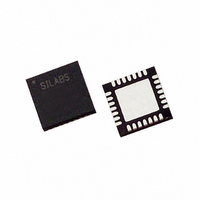C8051F353-GM Silicon Laboratories Inc, C8051F353-GM Datasheet - Page 185

C8051F353-GM
Manufacturer Part Number
C8051F353-GM
Description
IC 8051 MCU 8K FLASH 28MLP
Manufacturer
Silicon Laboratories Inc
Series
C8051F35xr
Specifications of C8051F353-GM
Program Memory Type
FLASH
Program Memory Size
8KB (8K x 8)
Package / Case
28-VQFN Exposed Pad, 28-HVQFN, 28-SQFN, 28-DHVQFN
Core Processor
8051
Core Size
8-Bit
Speed
50MHz
Connectivity
SMBus (2-Wire/I²C), SPI, UART/USART
Peripherals
POR, PWM, Temp Sensor, WDT
Number Of I /o
17
Ram Size
768 x 8
Voltage - Supply (vcc/vdd)
2.7 V ~ 3.6 V
Data Converters
A/D 8x16b; D/A 2x8b
Oscillator Type
Internal
Operating Temperature
-40°C ~ 85°C
Processor Series
C8051F3x
Core
8051
Data Bus Width
8 bit
Data Ram Size
768 B
Interface Type
I2C/SMBus/SPI/UART
Maximum Clock Frequency
50 MHz
Number Of Programmable I/os
17
Number Of Timers
4
Operating Supply Voltage
2.7 V to 3.6 V
Maximum Operating Temperature
+ 85 C
Mounting Style
SMD/SMT
3rd Party Development Tools
KSK-SL-TOOLSTICK, PK51, CA51, A51, ULINK2
Development Tools By Supplier
C8051F350DK
Minimum Operating Temperature
- 40 C
On-chip Adc
8-ch x 16-bit
On-chip Dac
2-ch x 8-bit
No. Of I/o's
17
Ram Memory Size
768Byte
Cpu Speed
50MHz
No. Of Timers
4
Rohs Compliant
Yes
Package
28QFN
Device Core
8051
Family Name
C8051F35x
Maximum Speed
50 MHz
Data Rom Size
128 B
Height
0.88 mm
Length
5 mm
Supply Voltage (max)
3.6 V
Supply Voltage (min)
2.7 V
Width
5 mm
Lead Free Status / RoHS Status
Lead free / RoHS Compliant
For Use With
770-1006 - ISP 4PORT FOR SILABS C8051F MCU336-1083 - DEV KIT FOR F350/351/352/353
Eeprom Size
-
Lead Free Status / Rohs Status
Lead free / RoHS Compliant
Other names
336-1273
Available stocks
Company
Part Number
Manufacturer
Quantity
Price
Company:
Part Number:
C8051F353-GM
Manufacturer:
SiliconL
Quantity:
8 050
21.3. SPI0 Slave Mode Operation
When SPI0 is enabled and not configured as a master, it will operate as a SPI slave. As a slave, bytes are
shifted in through the MOSI pin and out through the MISO pin by a master device controlling the SCK sig-
nal. A bit counter in the SPI0 logic counts SCK edges. When 8 bits have been shifted into the shift register,
the SPIF flag is set to logic 1, and the byte is copied into the receive buffer. Data is read from the receive
buffer by reading SPI0DAT. A slave device cannot initiate transfers. Data to be transferred to the master
device is pre-loaded into the shift register by writing to SPI0DAT. Writes to SPI0DAT are double-buffered,
and are placed in the transmit buffer first. If the shift register is empty, the contents of the transmit buffer
will immediately be transferred into the shift register. When the shift register already contains data, the SPI
will load the shift register with the transmit buffer’s contents after the last SCK edge of the next (or current)
SPI transfer.
When configured as a slave, SPI0 can be configured for 4-wire or 3-wire operation. The default, 4-wire
slave mode, is active when NSSMD1 (SPI0CN.3) = 0 and NSSMD0 (SPI0CN.2) = 1. In 4-wire mode, the
NSS signal is routed to a port pin and configured as a digital input. SPI0 is enabled when NSS is logic 0,
and disabled when NSS is logic 1. The bit counter is reset on a falling edge of NSS. Note that the NSS sig-
nal must be driven low at least 2 system clocks before the first active edge of SCK for each byte transfer.
Figure 21.4 shows a connection diagram between two slave devices in 4-wire slave mode and a master
device.
3-wire slave mode is active when NSSMD1 (SPI0CN.3) = 0 and NSSMD0 (SPI0CN.2) = 0. NSS is not
used in this mode, and is not mapped to an external port pin through the crossbar. Since there is not a way
of uniquely addressing the device in 3-wire slave mode, SPI0 must be the only slave device present on the
bus. It is important to note that in 3-wire slave mode there is no external means of resetting the bit counter
that determines when a full byte has been received. The bit counter can only be reset by disabling and re-
enabling SPI0 with the SPIEN bit. Figure 21.3 shows a connection diagram between a slave device in 3-
wire slave mode and a master device.
21.4. SPI0 Interrupt Sources
When SPI0 interrupts are enabled, the following four flags will generate an interrupt when they are set to
logic 1:
Note that all of the following bits must be cleared by software.
1. The SPI Interrupt Flag, SPIF (SPI0CN.7) is set to logic 1 at the end of each byte transfer. This
2. The Write Collision Flag, WCOL (SPI0CN.6) is set to logic 1 if a write to SPI0DAT is attempted
3. The Mode Fault Flag MODF (SPI0CN.5) is set to logic 1 when SPI0 is configured as a master,
4. The Receive Overrun Flag RXOVRN (SPI0CN.4) is set to logic 1 when configured as a slave,
flag can occur in all SPI0 modes.
when the transmit buffer has not been emptied to the SPI shift register. When this occurs, the
write to SPI0DAT will be ignored, and the transmit buffer will not be written.This flag can occur
in all SPI0 modes.
and for multi-master mode and the NSS pin is pulled low. When a Mode Fault occurs, the
MSTEN and SPIEN bits in SPI0CN are set to logic 0 to disable SPI0 and allow another master
device to access the bus.
and a transfer is completed while the receive buffer still holds an unread byte from a previous
transfer. The new byte is not transferred to the receive buffer, allowing the previously received
data byte to be read. The data byte which caused the overrun is lost.
Rev. 1.1
C8051F350/1/2/3
185











